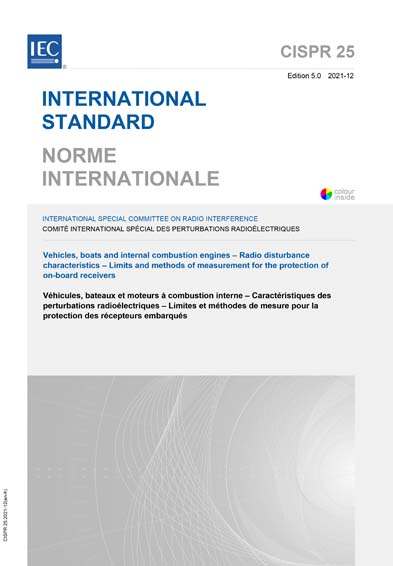Most recent
CISPR 25 Ed. 5.0 b:2021
Vehicles, boats and internal combustion engines - Radio disturbance characteristics - Limits and methods of measurement for the protection of on-board receivers
CISPR 25:2021 contains limits and procedures for the measurement of radio disturbances in the frequency range of 150 kHz to 5 925 MHz. This document applies to vehicles, boats, internal combustion engines, trailers, devices and any electronic/electrical component intended for use in vehicles, boats, trailers and devices. Refer to International Telecommunications Union (ITU) publications for details of frequency allocations. The limits are intended to provide protection for on-board receivers installed (per the manufacturer’s guidelines) in a vehicle from disturbances produced by components/modules in the same vehicle. The receiver types to be protected are, for example, broadcast receivers (sound and television), land mobile radio, radio telephone, amateur, citizens' radio, Satellite Navigation (GPS etc.), Wi-Fi, V2X, and Bluetooth. This document does not include protection of electronic control systems from radio frequency (RF) emissions or from transient or pulse-type voltage fluctuations. These subjects are included in ISO publications. The limits in this document are recommended and subject to modification as agreed between the customer (e.g. vehicle manufacturer) and the supplier (e.g. component manufacturer). This document is also intended to be applied by vehicle manufacturers and suppliers which are to be added and connected to the vehicle harness or to an on-board power connector after delivery of the vehicle. This document defines test methods for use by vehicle manufacturers and suppliers, to assist in the design of vehicles and components and ensure controlled levels of on-board radio frequency emissions. The emission requirements in this document are not intended to be applicable to the intentional transmissions from a radio transmitter as defined by the ITU including their spurious emissions.
NOTE 1 This exclusion is limited to those intended transmitter emissions, which leave the EUT as radiated emissions and are coupled onto the wire line in the measurement setup. For conducted transmissions on frequencies intentionally produced by the radio part of an EUT, this exclusion does not apply.
NOTE 2 It is usual for customers and suppliers to use radio regulation standards to manage the effect of spurious emissions from a radio transmitter unless limits of spurious emission are agreed in the test plan.
This fifth edition cancels and replaces the fourth edition published in 2016. This edition constitutes a technical revision. This edition includes the following significant technical changes with respect to the previous edition:
- inclusion of new frequency bands,
- deletion of the annex on TEM cells,
- inclusion of annexes on measurement uncertainty,
- overall improvement.
International Electrotechnical Commission [iec]

